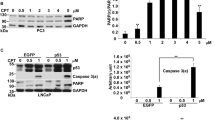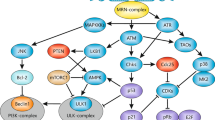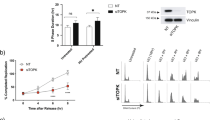Abstract
The ‘human topoisomerase I (htopoI) damage response’ was reported to be triggered by various kinds of DNA lesions. Also, a high and persistent level of htopoI cleavage complexes correlated with apoptosis. In the present study, we demonstrate that DNA damage-independent induction of cell death using colcemid and tumor necrosis factor α is also accompanied by a strong htopoI response that correlates with the onset of apoptotic hallmarks. Consequently, these results suggest that htopoI cleavage complex formation may be caused by signaling pathways independent of the kind of cellular stress. Thus, protein interactions or signaling cascades induced by DNA damage or cellular stress might lead to the formation of stabilized cleavage complexes rather than the DNA lesion itself. Finally, we show that p53 not only plays a key role in the regulation of the htopoI response to UV-C irradiation but also to treatment with colcemid.
This is a preview of subscription content, access via your institution
Access options
Subscribe to this journal
Receive 50 print issues and online access
$259.00 per year
only $5.18 per issue
Buy this article
- Purchase on Springer Link
- Instant access to full article PDF
Prices may be subject to local taxes which are calculated during checkout







Similar content being viewed by others
References
Aruoma OI, Halliwell B, Hoey BM, Butler J . (1989). Free Radic Biol Med 6: 593–597.
Bradford M . (1976). Anal Biochem 72: 248–254.
Casciola-Rosen L, Anhalt G, Rosen A . (1995). J Exp Med 181: 1557–1561.
Champoux JJ . (2001). Annu Rev Biochem 70: 369–413.
Chen X, Ko LJ, Jayaraman L, Prives C . (1996). Genes Dev 10: 2438–2451.
Daroui P, Desai SD, Li TK, Liu AA, Liu LF . (2004). J Biol Chem 279: 14587–14594.
Hsiang YH, Hertzberg R, Hecht S, Liu LF . (1985). J Biol Chem 260: 14873–14878.
Huppertz B, Frank HG, Kaufmann P . (1999). Anat Embryol (Berlin) 200: 1–18.
Janicke RU, Sprengart ML, Wati MR, Porter AG . (1998). J Biol Chem 273: 9357–9360.
Kaufmann SH, Desnoyers S, Ottaviano Y, Davidson NE, Poirier GG . (1993). Cancer Res 53: 3976–3985.
Lanza A, Tornaletti S, Rodolfo C, Scanavini M, Pedrini A . (1996). J Biol Chem 271: 6978–6986.
Li TK, Liu LF . (2001). Annu Rev Pharmacol Toxicol 41: 53–77.
Mao Y, Muller MT . (2003). DNA Repair (Amsterdam) 2: 1115–1126.
Mao Y, Okada S, Chang L, Muller M . (2000). Cancer Res 60: 4538–4543.
Pommier Y, Kohlhagen G, Laco GS, Kroth H, Sayer JM, Jerina DM . (2002). J Biol Chem 277: 13666–13672.
Pommier Y, Kohlhagen G, Pourquier P, Sayer J, Kroth H, Jerina D . (2000). Proc Natl Acad Sci USA 97: 2040–2045.
Pourquier P, Bjornsti M, Pommier Y . (1998). J Biol Chem 273: 27245–27249.
Pourquier P, Gioffre C, Kohlhagen G, Urasaki Y, Goldwasser F, Hertel L et al. (2002). Clin Cancer Res 8: 2499–2504.
Pourquier P, Pilon A, Kohlhagen G, Mazumder A, Sharma A, Pommier Y . (1997a). J Biol Chem 272: 26441–26447.
Pourquier P, Takebayashi Y, Urasaki Y, Gioffre C, Kohlhagen G, Pommier Y . (2000). Proc Natl Acad Sci USA 97: 1885–1890.
Pourquier P, Ueng L, Fertala J, Wang D, Park H, Essigmann J et al. (1999). J Biol Chem 274: 8516–8523.
Pourquier P, Ueng L, Kohlhagen G, Mazumder A, Gupta M, Kohn K et al. (1997b). J Biol Chem 272: 7792–7796.
Pourquier P, Waltman J, Urasaki Y, Loktionova N, Pegg A, Nitiss J et al. (2001). Cancer Res 61: 53–58.
Salvesen GS, Dixit VM . (1997). Cell 91: 443–446.
Samejima K, Svingen P, Basi G, Kottke T, Mesner PJ, Stewart L et al. (1999). J Biol Chem 274: 4335–4340.
Sherwood SW, Sheridan JP, Schimke RT . (1994). Exp Cell Res 215: 373–379.
Soe K, Rockstroh A, Schache P, Grosse F . (2004). DNA Repair (Amsterdam) 3: 387–393.
Sordet O, Khan QA, Plo I, Pourquier P, Urasaki Y, Yoshida A et al. (2004a). J Biol Chem 279: 50499–50504.
Sordet O, Liao Z, Liu H, Antony S, Stevens EV, Kohlhagen G et al. (2004b). J Biol Chem 279: 33968–33975.
Stewart A, Herrera R, Nordheim A . (1990). Cell 60: 141–149.
Subramanian D, Rosenstein B, Muller M . (1998). Cancer Res 58: 976–984.
Wajant H, Pfizenmaier K, Scheurich P . (2003). Cell Death Differ 10: 45–65.
Wolf BB, Schuler M, Echeverri F, Green DR . (1999). J Biol Chem 274: 30651–30656.
Acknowledgements
We are grateful to Dr Carol Prives (Columbia University, NY, USA) for providing us with the H1299-TOFF-p53 cell line. This work was supported by grant Gr 895/15-1/2 of the ‘Deutsche Forschungsgemeinschaft’.
Author information
Authors and Affiliations
Corresponding author
Additional information
Supplementary Information accompanies the paper on Oncogene website (http://www.nature.com/onc).
Rights and permissions
About this article
Cite this article
Rockstroh, A., Kleinert, A., Kramer, M. et al. Cellular stress triggers the human topoisomerase I damage response independently of DNA damage in a p53 controlled manner. Oncogene 26, 123–131 (2007). https://doi.org/10.1038/sj.onc.1209766
Received:
Revised:
Accepted:
Published:
Issue Date:
DOI: https://doi.org/10.1038/sj.onc.1209766
Keywords
This article is cited by
-
DNA cleavage assay for the identification of topoisomerase I inhibitors
Nature Protocols (2008)



